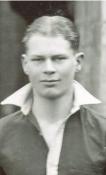
|
The King's School Canterbury |
Roll of Honour |
| Captain Alexander George KINNAIRD (85615) | |
|
1st Battalion West Yorkshire Regiment (Prince of Wales' Own) Date of birth: 30th December 1918 Date of death: 30th March 1942 Killed in action aged 23 Commemorated on the Rangoon Memorial Face 7 |

|
| He was born at St Margaret-at-Cliffe on the 30th of December 1918, the only son of George Thomas Kinnaird, bank clerk, and Elsa (nee Zillersen) of St Margaret-at-Cliffe, Kent. He was educated at the Junior King's School from September 1929 and at the King's School Canterbury from April 1932 to March 1936, where he was in The Grange. He was a member of the 1st XV Rugby in 1934 and 1935, of the 1st XI Hockey team, and was Vice-Captain of Fencing. He was the husband of Beresford "Berry" Eileen (nee Havelock) who he had met in India. They had a daughter. He was commissioned as a 2nd Lieutenant in the West Yorkshire Regiment on the 26th of January 1939. He was promoted temporary Captain on the 11th of August 1940 and to Lieutenant on the 1st of January 1941. He was promoted to Captain in 1942. He continued to play rugby while he was based in India. The battalion was mobilised as soon as the Japanese invaded Burma and arrived there in January 1942. Alexander Kinnaird was not with them when they landed but arrived on the 14th of February 1942, while the battalion were in the field at Thanatpin. He was sent to be Liaison Officer for the battalion at the Headquarters of 17th Division. The next day 17th Division were ordered to begin the retreat from Burma. On the 20th of March Alexander Kinnaird returned to the battalion when they were at Kyudawgan, two miles to the north of Paungde, and was given command of A Company as its commanding officer had been taken ill. On the 26th the retreat continued and the battalion moved to Tamanauk on the 26th and by the 29th they were at Paungne. At 8 pm on the 29th they arrived at Shwedaung and at midnight A Company were ordered to "feel their way forward" which they did but soon came under heavy fire and fell back, remaining in a defensive position until first light. At 6.15am on the 30th of March 1942 orders were issued for an attack. Lt Col Marindin MC was commanding a composite force of infantry; Cameronians were to attack to the east of the road into Shwedaung with a party of Gloucesters left of the road and A Company were on the extreme left flank. The objective of this attack was to sweep thought Shwedaung from the south and clear away all opposition. At 7am A Company was deployed, ready to go forward and the advance commenced directly the artillery concentration lifted. The company moved with two platoons up (8 platoon on the right, with 7 Platoon on the left) and 9 Platoon in reserve with Company Headquarters. Directly A Company crossed the road it came under fire from its left rear. 9 Platoon, assisted by tanks, dealt with this. During this time 7 and 8 Platoons were coming under intermittent small arms fire from some woods to the south west of Shwedaung. The gap between 7 and 8 Platoons had widened as 8 Platoon were ordered to keep contact with the Gloucesters. 9 Platoon came up and the advance continued to the Irrawaddy. Considerable fire was coming from Shwedaung itself and Captain Kinnaird, with 9 Platoon, moved eastwards through the streets of the town. 8 Platoon was by this time out of sight and contact. As 9 Platoon moved through Shwedaung Alexander Kinnaird went forward on his own to make a reconnaissance. During this reconnaissance he was shot by a sniper from the back and killed. Captain F. J. Wright, as company second in command, took over the command of the company and with 7 and 9 Platoons, moved north through the west side of Shwedaung in accordance with the orders given. Still coming under mortar and light machine gun fire 7 and 9 Platoons eventually cleared the western sector and came out to the north of the town. Meanwhile 8 Platoon had wheeled with the Gloucesters on to the blockers and, when these were removed, the platoon started to move forward. It soon became apparent that a pocket of Japanese resistance still existed just to the west of the road as mortar fire was opened on the Platoon knocking out some vehicles and blocking the road. At about 15.00 hours the vehicles waiting to go though were heavily dive bombed and orders were received later in the afternoon to abandon the vehicles south of Shwedaung. A Company regrouped north of the village and moved back to the original area north of Prome on tanks of 7th Hussars which had broken through. This action cost the battalion casualties of nine men killed, including Captain Kinnaird and Colour Sergeant Broadhead, 11 other ranks were wounded with two missing. He is commemorated on the war memorial the St Margaret's of Antioch Church at Cliffe in Kent. |
|
| The Grange |
Back